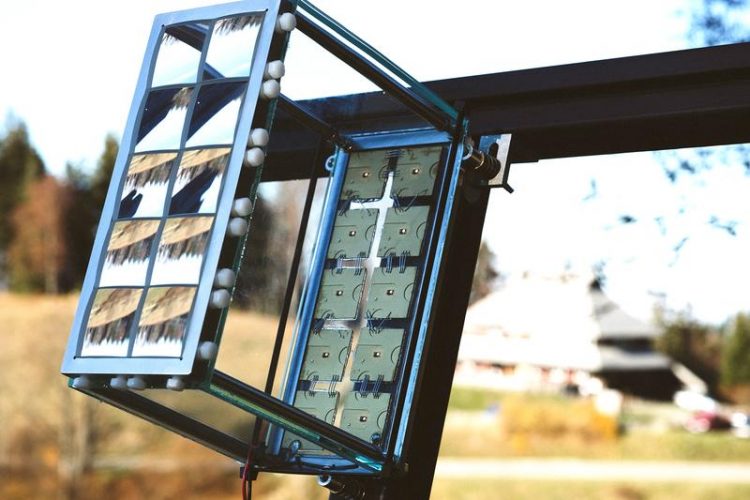Concentrator Photovoltaics Shows Peak Performance – Module Efficiency Reaches 41.4 %

High-Concentration Photovoltaic (HCPV) Module with record high efficiency. 41.4% of the direct solar irradiation is converted into electricity. © Fraunhofer ISE/Alexander Wekkeli
High-concentration photovoltaic (HCPV) systems offer renewable electricity with the highest conversion efficiency and thus a correspondingly low use of resources especially in regions with high direct normal irradiance.
In this technology multi-junction solar cells, based on III-V compound semiconductors, are used. In these solar cells, several thin subcells are stacked on top of each other in order to convert the solar irradiance more efficiently. Optical lenses concentrate the incoming sunlight onto the miniature sized solar cells. The modules are mounted on a two-axis tracking system that follows the sun’s path during the day.
The industrial implementation of highest efficiencies for concentrator PV modules and thus the reduction of the gap between research results and industry production were the focus of the CPVMatch project. Headed by Fraunhofer ISE, a consortium of research institutes and industry partners from Germany, Italy, Spain and France have worked on new solutions over the past 3.5 years to this end.
“In CPVMatch, we have addressed all production steps for concentrator modules starting from the materials, through cell fabrication and production systems, and up to the challenges facing module manufacturing,” reports Dr. Gerald Siefer, project head and group leader of III-V Cell and Module Characterization at Fraunhofer ISE.
The project partners have achieved two major results: By using innovative cell architectures for multi-junction solar cells with new materials, processes and manufacturing equipment, the researchers were able to optimize the production of four-junction solar cells.
Also, they were able to improve the design of high-concentration modules, primarily by modifying the optics and making use of achromatic lenses. The combination of four-junction solar cells with achromatic lenses has led to the new record efficiency of 41.4 percent for a 122 cm² module.
“We are extremely pleased about these results that pave the way for further efficiency increases in the concentrator technology,” says Dr. Andreas Bett, institute director of Fraunhofer ISE. “Photovoltaics is booming worldwide, and we see great potential for this particularly efficient module technology.
It significantly decreases the use of resources for energy conversion per unit area and thus contributes to more sustainability.”
https://www.ise.fraunhofer.de/en/press-media/press-releases/2018/concentrator-ph…
Media Contact
All latest news from the category: Power and Electrical Engineering
This topic covers issues related to energy generation, conversion, transportation and consumption and how the industry is addressing the challenge of energy efficiency in general.
innovations-report provides in-depth and informative reports and articles on subjects ranging from wind energy, fuel cell technology, solar energy, geothermal energy, petroleum, gas, nuclear engineering, alternative energy and energy efficiency to fusion, hydrogen and superconductor technologies.
Newest articles

Long-sought structure of powerful anticancer natural product
…solved by integrated approach. A collaborative effort by the research groups of Professor Haruhiko Fuwa from Chuo University and Professor Masashi Tsuda from Kochi University has culminated in the structure…

Making a difference: Efficient water harvesting from air possible
Copolymer solution uses water-loving differential to induce desorption at lower temperatures. Harvesting water from the air and decreasing humidity are crucial to realizing a more comfortable life for humanity. Water-adsorption…

In major materials breakthrough
UVA team solves a nearly 200-year-old challenge in polymers. UVA researchers defy materials science rules with molecules that release stored length to decouple stiffness and stretchability. Researchers at the University…



